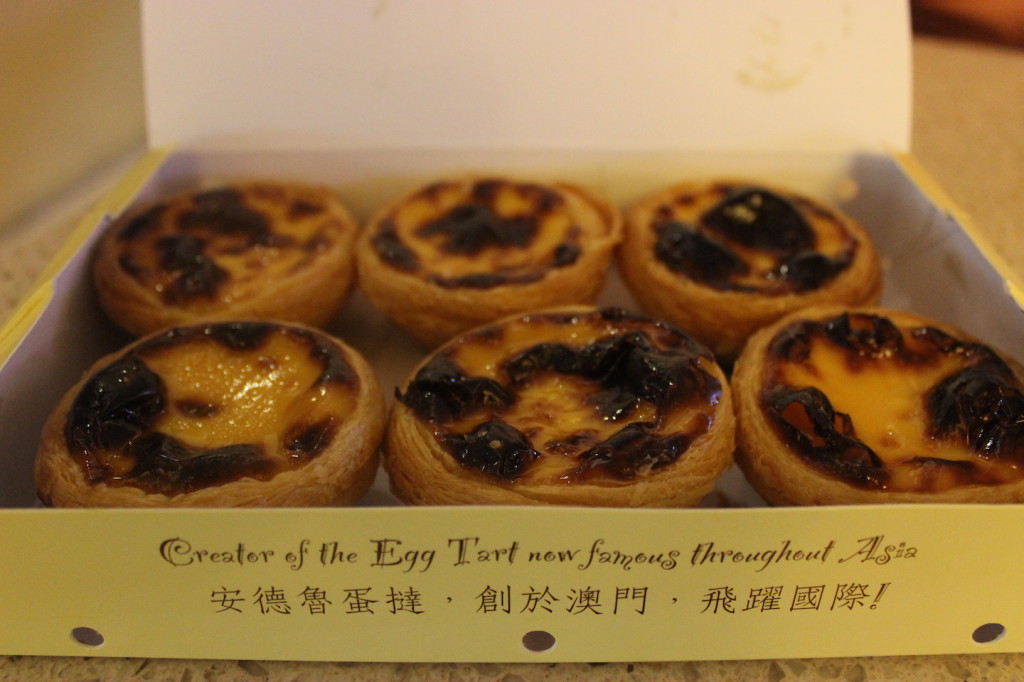Macau was a very interesting place for Carlos and I. It is the only place in the world where the two cultures of our heritage collided and created a city. Macau was a Portuguese colony just like Brazil, but inhabited by Chinese descendants. It was really strange to have Chinese and Portuguese signs next to each other on everything, to hear Chinese and Portuguese spoken one after the other. Needless to say, it’s a very unique place.

Senado Square (Largo do Senado)
Senado Square is Macau’s urban center, home to historic European-style buildings, stores and restaurants. The square extends itself all the way to the Ruins of St. Paul’s and is always packed with tourists walking on its Portuguese-style pavement with black and white stones that reminded me of Copacabana in Rio. The day we visited, an inflatable Chinese-style gate was on display for the upcoming Mid-Autumn Festival, a direct contrast to the otherwise European look of the square.

Ruins of St. Paul’s (Ruínas de São Paulo)
This cathedral served for a long time as the main church in Asia until Hong Kong took over as the main port and it was burnt down in 1835. Only the southern façade of the cathedral is left after the fire, but what remains is Macau’s most well-known historical landmark.

Monte Forte (Fortaleza do Monte)
Apparently it’s a very Portuguese thing to build forts. Monte Forte was the military center of Macau and cannons still line the fortress walls today. Panoramic views of mainland Macau can be seen at the top of the fort. It was quite the sight to see old, worn down buildings next to shiny, fancy casinos.

Macau Tower (Torre de Macau)
As is now tradition, we arrived when it was still light out and stayed through the sunset. Macau Tower offers views of mainland Macau, the islands of Taipa and Coloane, the Cotai strip, as well as Zhuhai in China and the the entire Pearl River Delta. I personally thought the night view was better – imagine Vegas at night. All three bridges connecting mainland Macau to Taipa/Cotai/Coloane were beautiful. It was also really fun to watch people bungee jump from the building, literally looking like they’re falling from the sky outside the window. You knew someone jumped because a bunch of people would scream, haha.

Casinos
Besides the cultural mix, Macau is also like Las Vegas. It has 33 casinos generating an impressive $33 billion of revenue, more than five times that of the Las Vegas strip. We couldn’t leave without visiting some of the casinos.
Grand Lisboa
The most iconic casino in Macau, it’s impossible for you to come here and not see this giant lotus flower-shaped building standing out in the skyline. The Grand Lisboa was our casino of choice – we had a delicious meal, we fed our intellectual minds with art, we gambled (only a few dollars) and we watched people lose thousands of dollars in seconds. What else could we have asked for?

The Venetian Macau
The Venetian Macau looks a lot like its sister casino in Las Vegas, with canals and gondola rides, except this one is a much more exaggerated version – it is the largest casino and the 7th largest building in the world! There are hundreds of shops, restaurants and entertainment options to give you no incentive to ever leave the building.

Food
It’s no surprise that food in Macau is also very unique, especially in Asia. We regrettably were not able to have a Portuguese meal (the famous restaurants were either too far or too expensive), but we did try some local favorites.
Portuguese Egg Tart (Pastéis de Belém)
I don’t normally like egg tarts, but I did like Portuguese egg tarts. There are two key differences. First, the crust is made of a layered, flaky puff pastry instead of shortcrust pastry – this makes the crust lighter so the egg custard flavour is more prominent. Second, parts of the egg custard have been caramelized so it’s a bit sweeter with a less egg-y texture. We went to the famed Lord Stow’s Bakery for the best Portuguese egg tarts in all of Macau and were not disappointed.

Pork Chop Bun
This is the most popular snack in Macau. It was as the name describes – a pork chop in a bun. The pork chop is fried so it’s crispy on the outside but soft on the inside. Traditionally it’s just the pork chop inside a bun, but the one we had also had tomatoes, cucumbers, and lettuce.

Our two days in Macau were both cultural and fun. We enjoyed visiting a place where both of our cultures are present and we are glad such a place exists!

